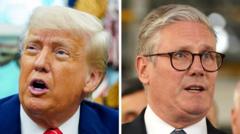On April 28, 2025, Canadians are casting their votes in a pivotal federal election, determining not only the country's leadership but also its economic trajectory, particularly in light of ongoing tensions with President Trump's administration. The Liberal Party, led by Prime Minister Mark Carney, has surged in recent polls, overtaking the Conservative Party, led by Pierre Poilievre, which had previously enjoyed a significant lead.
Canada's Crucial Election: A Battle Against Trump's Influence

Canada's Crucial Election: A Battle Against Trump's Influence
As Canadians head to the polls, the political landscape is shifting dramatically; the Liberal Party, under new leadership, gains momentum against the once-dominant Conservatives amid President Trump's trade threats.
The stakes are high. Recent polls suggest the Liberal Party jumps ahead while the Conservatives, long thought to have a secure grasp on power, are now scrambling to maintain relevance. The landscape shifted rapidly following Trump’s aggressive trade policies and tariff impositions, which threatened Canada's economic stability and swayed public sentiment toward Carney and the Liberals.
Canada's political structure operates under a parliamentary system, where voters select representatives in their local ridings. The party that secures the most seats will form the government. The election features three additional parties—the New Democratic Party, the Bloc Québécois, and the Green Party, each expected to secure limited numbers of seats.
Mark Carney’s ascent comes after Justin Trudeau's resignation and has redefined what many consider a conservative identity in Canada. Carney has positioned himself as a stabilizing force, advocating against Trump-esque ideologies while drawing on his experience as a former central banker to assure voters of his ability to navigate complex economic challenges.
On the other hand, Poilievre faces headwinds due to his vocal support for deregulation, a smaller federal government, and other policies mirroring Trump’s ideology. This alignment could alienate moderate voters wary of those associations, especially given the current hostility towards Trump across much of Canada.
Polls opened in a staggered manner across the country's six time zones, with results expected late in the evening. Despite the electoral discontent, including a significant housing crisis affecting many voters, both parties have pledged relief measures in their campaigns, attempting to draw critical votes in the closing hours of election day.
The election serves as a referendum on the country's future amidst external pressures, showcasing a political battle that reflects broader global uncertainties and the evolving relationship Canada must navigate with its neighbor to the south.
As Canadians weigh their choices, the outcome will resonate well beyond its borders, especially in light of ongoing diplomatic tensions and economic threats posed by the current U.S. administration. The new Prime Minister will need not only to lead domestically but also to navigate an increasingly fraught geopolitical landscape as the election results unfold.
Canada's political structure operates under a parliamentary system, where voters select representatives in their local ridings. The party that secures the most seats will form the government. The election features three additional parties—the New Democratic Party, the Bloc Québécois, and the Green Party, each expected to secure limited numbers of seats.
Mark Carney’s ascent comes after Justin Trudeau's resignation and has redefined what many consider a conservative identity in Canada. Carney has positioned himself as a stabilizing force, advocating against Trump-esque ideologies while drawing on his experience as a former central banker to assure voters of his ability to navigate complex economic challenges.
On the other hand, Poilievre faces headwinds due to his vocal support for deregulation, a smaller federal government, and other policies mirroring Trump’s ideology. This alignment could alienate moderate voters wary of those associations, especially given the current hostility towards Trump across much of Canada.
Polls opened in a staggered manner across the country's six time zones, with results expected late in the evening. Despite the electoral discontent, including a significant housing crisis affecting many voters, both parties have pledged relief measures in their campaigns, attempting to draw critical votes in the closing hours of election day.
The election serves as a referendum on the country's future amidst external pressures, showcasing a political battle that reflects broader global uncertainties and the evolving relationship Canada must navigate with its neighbor to the south.
As Canadians weigh their choices, the outcome will resonate well beyond its borders, especially in light of ongoing diplomatic tensions and economic threats posed by the current U.S. administration. The new Prime Minister will need not only to lead domestically but also to navigate an increasingly fraught geopolitical landscape as the election results unfold.






















